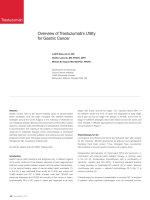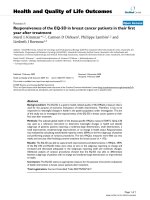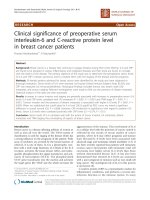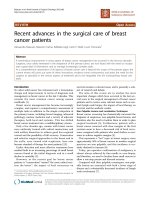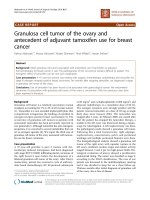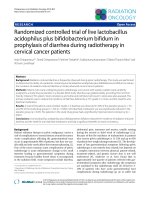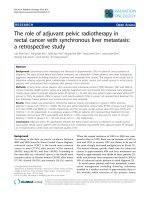Overexpression of synuclein-γ predicts lack of benefit from radiotherapy for breast cancer patients
Bạn đang xem bản rút gọn của tài liệu. Xem và tải ngay bản đầy đủ của tài liệu tại đây (3.27 MB, 12 trang )
Min et al. BMC Cancer (2016) 16:717
DOI 10.1186/s12885-016-2750-y
RESEARCH ARTICLE
Open Access
Overexpression of synuclein-γ predicts lack
of benefit from radiotherapy for breast
cancer patients
Li Min1,2† , Cheng Zhang1†, Ruolan Ma3, Xiaofan Li4, Hua Yuan5, Yihao Li2,6, Ruxuan Chen7, Caiyun Liu1,
Jianping Guo1, Like Qu1* and Chengchao Shou1*
Abstract
Background: Although radiotherapy following mastectomy was demonstrated to reduce the recurring risk and
improve the prognosis of patients with breast cancer, it is also notorious for comprehensive side effects, hence only
a selected group of patients can benefit. Therefore, the screening of molecular markers capable of predicting the
efficacy of radiotherapy is essential.
Methods: We have established a cohort of 454 breast cancer cases and selected 238 patients with indications for
postoperative radiotherapy. Synuclein-γ (SNCG) protein levels were assessed by immunohistochemistry, and SNCG
status was retrospectively correlated with clinical features and survival in patients treated or not treated with radiotherapy.
Gene Set Enrichment Analysis (GSEA) and survival analysis for online datasets were also performed for further validation.
Results: Among patients that received radiotherapy (82/238), those demonstrating positive SNCG expression had a 55.
0 month shorter median overall survival (OS) in comparison to those demonstrating negative SNCG expression (78.4 vs.
133.4 months, log rank χ2 = 16.13; p < 0.001). Among the patients that received no radiotherapy (156/238), SNCG status
was not correlated with OS (log rank χ2 = 2.40; p = 0.121). A COX proportional hazard analysis confirmed SNCG
as an independent predictor of OS, only for patients who have received radiotherapy. Similar results were also
obtained for distant metastasis-free survival (DMFS). A GSEA analysis indicated that SNCG was strongly associated with
genes related to a radiation stress response. A survival analysis was performed with online databases consisting of
breast cancer, lung cancer, and glioblastoma and further confirmed SNCG’s significance in predicting the survival of
patients that have received radiotherapy.
Conclusion: A positive SNCG may serve as a potential marker to identify breast cancer patients who are less likely to
benefit from radiotherapy and may also be extended to other types of cancer. However, the role of SNCG in
radiotherapy response still needs to be further validated in randomized controlled trials prior to being exploited
in clinical practice.
Keywords: Synuclein-γ, Radiotherapy, Prognosis, Breast cancer
Abbreviations: CI, Confidence interval; DAB, Diaminobenzidine; DMFS, Distant metastasis-free survival; ER, Estrogen
receptor; FDR, False discovery rate; GSEA, Gene set enrichment analysis; HR, Hazard ratios; IHC, Immunohistochemistry;
MSigDB, Molecular signatures database; NES, Normalized enrichment score; OS, Overall survival; ROS, Reactive oxygen
species; SNCG, Synuclein-γ
* Correspondence: ;
†
Equal contributors
1
Department of Biochemistry and Molecular Biology, Key Laboratory of
Carcinogenesis and Translational Research (Ministry of Education), Peking
University Cancer Hospital & Institute, Beijing 100142, China
Full list of author information is available at the end of the article
© 2016 The Author(s). Open Access This article is distributed under the terms of the Creative Commons Attribution 4.0
International License ( which permits unrestricted use, distribution, and
reproduction in any medium, provided you give appropriate credit to the original author(s) and the source, provide a link to
the Creative Commons license, and indicate if changes were made. The Creative Commons Public Domain Dedication waiver
( applies to the data made available in this article, unless otherwise stated.
Min et al. BMC Cancer (2016) 16:717
Background
Breast cancer is the most frequently diagnosed cancer
among females worldwide [1]. In more developed countries like the U.S., breast cancer death rates have slowly
decreased by 1.4 % per year [2, 3]; however, in less developed areas, both of the incidence rate and mortality rate
of breast cancer are still raising [1]. In 2013, breast cancer accounted for 25 % of total cancer cases and 15 % of
cancer-related deaths worldwide [1]. For decades, surgical removal of the primary tumor has been the major
therapeutic option [4, 5], and the addition of adjuvant
radiotherapy based on a risk of recurrence and metastasis has been found to significantly improve the overall
prognosis. Currently, adjuvant radiotherapy after mastectomy has been widely accepted as the gold standard of
care for patients with tumors > 5 cm in size, 4 or more
positive lymph nodes, or positive margins [6]. However,
radiotherapy is also associated with potential long-term
side effects and radiation oncologists have to be highly
selective of patients and administer radiation treatments
with extreme caution [6, 7]. Despite such precautions,
not every patient subjected to radiotherapy can particularly benefit from it. Thus, biomarkers capable of predicting radiotherapeutic efficacy would largely strengthen
current clinical options by providing instructions for appropriate risk evaluation and treatment plan selection.
Synuclein-γ (SNCG) was first identified as breast cancer–specific gene 1 (BCSG1), and was isolated from
cDNA libraries of breast carcinoma in the 1990s [8, 9].
SNCG is highly expressed in advanced and metastatic
breast tumors but not in normal breast epithelium tissues.
In breast cancer cells, SNCG protein impairs cell cycle
checkpoints [10, 11], confers chemoresistance [12, 13],
and enhances metastasis in nude mice [14]. Although the
detailed mechanism is not fully understood, SNCG’s role
in the oncogenesis-related Akt and mTOR pathways [15]
and the neural development-related PPARγ pathway [16]
are noteworthy and worth further investigation. The poor
overall SNCG-related prognosis in breast cancer has been
reported by two independent studies [17, 18]. Moreover,
SNCG was overexpressed in other cancerous tissues and
this overexpression was a prediction of poor prognosis in
several types of cancer [17–22]. Nevertheless, the relationship between SNCG expression and radiotherapeutic efficacy remains to be elucidated.
The aim of this study is to explore the impact of
SNCG expression on the prognosis as well as multiple
clinical manifestations of breast cancer patients treated
with radiotherapy. Surgically resected specimens from
breast cancer patients as well as expression profiling
datasets from online repositories were simultaneously
analyzed. SNCG expression and its relationship with
pathological parameters were investigated on both protein and transcript levels, and high SNCG expression
Page 2 of 12
were suggested to be an indication of fewer radiotherapeutic benefits. Furthermore, our finding was also validated by analysis performed in two online datasets of
different cancer types with radiotherapy information. In
conclusion, this study has revealed the prospective value
of SNCG expression in predicting whether breast cancer
patients could benefit from radiotherapy, and could further potentially be used as a significant parameter for
cancer adjuvant treatment.
Methods
Patient selection
A cohort of 454 invasive breast cancer patients that received radical or modified radical mastectomy between
the years of 1996 and 2002 in the Breast Center at the
Peking University Cancer Hospital & Institute. The project was approved and supervised by the research ethics
committee of Peking University Cancer Hospital & Institute. Written informed consents were obtained from all
participants. Patients with indications for postoperative
radiotherapy were recruited: patients with T3/4 tumors
(i.e. tumor size > 5 cm in size, or positive margins), patients with four or more positive lymph nodes, T1/2 patients with one to three positive nodes and other risk
factors of recurrence (i.e. ≤ 40 years old, hormone
receptor-negative, HER2 positive, incomplete lymph
node dissection or more than 20 % positive nodes). The
presence of ER and PR was evaluated using the
charcoal-dextran method. ER and PR values of more
than 10 fmol/mg were considered positive. Status of
HER2 was assessed by IHC with a rabbit polyclonal antibody (DAKO A0485; 1:250 dilution), and scored by the
Diagnostic Pathological Department, Peking University
Cancer Hospital. Eight fields were randomly selected in
each slide and slides were counted under a Nikon
microscope at 200× amplification [17]. Among the
454 breast cancer patient cohort, 238 of the cases
with indications for postoperative radiotherapy were
selected while only 82 of them had been treated with
radiotherapy. No patients involved in this study have
received neoadjuvant chemotherapy.
Radiotherapy treatment
Overall, there were 238 patients with indications for
postoperative radiotherapy that were selected. The selected patients were aged from 25 to 81 years (median
52 years). 82 of them were typically treated with standard radiotherapy in 25 fractions (50 Gy at 2 Gy per fraction, 5 fractions per week), and ensured that the
radiotherapy dose was actually delivered to the CTV
(clinical target volume) with 6 MV photons or electron
beam. The remaining 156 patients had not been subjected to radiotherapy.
Min et al. BMC Cancer (2016) 16:717
Clinical samples handling
Surgically resected tissue specimens were used in this
study. Formalin fixed, paraffin-embedded breast cancer
tissue specimens from the above 238 patients were obtained from the Breast Center at Peking University Cancer
Hospital & Institute. The study was approved and supervised by the Medical Ethics Committee of Peking
University Cancer Hospital & Institute and each patient had given formal consent. All specimens were
taken before the onset of chemotherapy or hormonal
treatment. The total period of follow-up was 60–192
months with a median period of 127 months.
Page 3 of 12
with radiotherapy information [24, 25]. Both of the
two datasets with their supplementary clinical information were downloaded and used for validating analysis. A pearson correlation analysis was performed to
assess the gene-gene expression correlation. A hierarchical
clustering was used to distinguish different subgroups according to expression level of given genes. Gene Set Enrichment Analysis (GSEA) was performed to evaluate
correlation between SNCG expression and two radiation
stress response gene sets [26, 27]. Lung cancer dataset
CaArray and glioblastoma dataset GSE13041 with radiotherapy information were also downloaded and used for
validating analysis [28–30].
Immunohistochemical staining
Specimens were cut into 5 μm sections. After baking at
60 °C overnight, sections were dewaxed and rehydrated
through xylene and alcohol series. Antigen retrieval was
performed via microwave cooking in ethylene diamine
tetra acetic acid (pH 8.0, Zymed) for 20 min. Endogenous peroxidase activity was blocked by incubation in 3 %
hydrogen peroxide for 10 min at room temperature.
Non-specific binding was blocked with 10 % goat serum.
Then slides were subjected to overnight incubation at 4 °C
with anti-SNCG monoclonal antibody generated in our laboratory [17]. After incubation with a biotin-conjugated
secondary anti-mouse antibody for 30 min and 3 washes
with phosphate-buffered saline with 0.1 % Tween-20,
slides were treated with diaminobenzidine (DAB) working
solution at room temperature for 3–10 min, and then
washed in distilled water and counterstained with
hematoxylin. The negative control was prepared by replacing the SNCG antibody with non-immune IgG in a
randomly selected breast cancer tissue slide, and the positive control was prepared with SNCG antibody in a
known SNCG positive breast cancer tissue slide which
had been proved in a previous study [17].
Statistical analysis
IHC grading system
IHC staining of SNCG was performed for all samples.
According to our grading criteria, 139 samples among
238 were defined as SNCG negative while another 99
were defined as SNCG positive (total positive rate =
41.6 %). Representative images of SNCG staining in
breast cancer tissues with examples of scoring were
shown in Fig. 1. Positive rates of SNCG were 41.5 %
(34/82) in patients that received radiotherapy and
41.7 % (65/156) in those that did not receive radiotherapy, and there was no significant difference (χ2 =
0.001, p = 0.976). For patients treated with radiotherapy or not, there were no significant associations
between SNCG expression and Age (p = 0.767, 0.665),
Tumor size (p = 0.145, 0.142), Metastasis lymph node
(p = 0.117, 0.332), TNM stage (p = 0.428, 0.957), ER
status (p = 0.304, 0.998), PR status (p = 0.171, 0.904),
or HER2 status (p = 0.351, 0.646), and all of the
All of the samples were independently inspected under a
light microscope (APPLIED IMAGING at 200×) by two
experienced pathologists. Both the percentage of positive
cells and the intensity of staining in 10 randomly chosen
microscopic fields were evaluated. According to our previous publications, the grading system was based on a 4value classification scale as follows: the area of staining was
graded as <10 % (0) or >10 % (1) of all cancer cells stained
within the section; intensity of staining was graded as none
(0), weak (1), moderate (2) or strong (3). The final grade
was obtained by adding area grade and intensity grade together, and final grade ≥ 3 was defined as positive [20, 23].
Validating analysis
EBI ArrayExpress dataset E-TABM-158 and NCBI GEO
dataset GSE1456 are two online breast cancer datasets
Since the populations of stage II patients in the radiotherapy subgroup were too small to perform a separate
multivariate analysis, we combined the samples in stage
II and III to make it sufficient for statistics. All statistical
analyses were performed using the R 3.1.2 software
(www.r-project.org). Correlations that were made between the SNCG expression and clinicopathologic characteristics were tested by the Pearson χ2 test. The
Kaplan-Meier curve was used to evaluate overall survival
(OS) and distant metastasis-free survival (DMFS) rates,
and differences were tested by log-rank test. The COX
proportional hazard model was used for multivariate
analysis. Hazard ratios (HR) and 95 % confidence
interval (CI) were calculated. All statistical analyses
were 2-sided, and a p value less than 0.05 were considered statistically significant. For false discovery rate
(FDR) analysis, a cutoff of 0.25 was selected according
to GSEA’s suggestion [26].
Results
Association of SNCG expression and clinicopathologic
features
Min et al. BMC Cancer (2016) 16:717
Page 4 of 12
Fig. 1 Representative immunohistochemical staining for SNCG expression in breast cancer tissues. a 100 × and b 200 × staining of negative
sample 1 (area grade 0, intensity grade 0); c 100 × and d 200 × staining of negative sample 2 (area grade 1, intensity grade 1); e 100 × and f
200 × staining of positive sample (area grade 1, intensity grade 3); g Staining of negative control (100×); h Staining of positive control (100×)
clinicopathologic features in both subgroups were
equally distributed (Table 1).
Relationship between SNCG expression and radiotherapy
stratified survival
Positive SNCG was correlated with decreased OS
(median OS: 108.3 vs. 144.6 months; log rank χ2 =
13.45; p < 0.001; Fig. 2a) and DMFS (median DMFS:
81.2 vs. 127.7 months; log rank χ2 = 17.83; p < 0.001;
Fig. 2d) in breast cancer patients, regardless of the
utilization or non-utilization of radiotherapy.
Among patients that received radiotherapy, those with
positive SNCG expression had a 55.0 months shorter
median OS than those with negative SNCG expression
(median OS: 78.4 vs. 133.4 months; log rank χ2 = 16.13;
p < 0.001; Fig. 2b). However, among patients that were
not subjected to radiotherapy, there was no significant
difference between OS of patients with positive SNCG
expression and those with negative SNCG expression
(median OS: 122.4 vs. 143.1 months; log rank χ2 = 2.40;
p = 0.121; Fig. 2c). Similar results were also obtained
for DMFS (for patients received radiotherapy, median
DMFS: 52.9 vs. 116.7 months, Fig. 2e; for patients did
not receive radiotherapy, median DMFS: 95.1 vs.
126.7 months, Fig. 2f ).
Univariate and multivariate analysis for the radiotherapy
stratified prognosis
In univariate analysis, tumor size, lymph nodes metastasis, TNM stage, SNCG expression were statistically associated with OS in patients that received radiotherapy,
while lymph nodes metastasis, TNM stage, and HER2
status were prognostic factors of OS in patients that did
not receive radiotherapy (Table 2).
Multivariate analyses using COX regression analysis
identified TNM stage (Wald χ2 = 10.31; p = 0.001) and
SNCG (Wald χ2 = 6.62; p = 0.010) expression, which
were both independent predictors of OS in patients that
received radiotherapy. However, in patients that did not
receive radiotherapy, only TNM stage (Wald χ2 = 7.32;
p = 0.007) remained an independent prognostic factor
(Table 3). Similar results were also obtained for
DMFS (Additional file 1: Table S1 and S2). Taken together,
SNCG expression affected the survival of breast cancer
patients to a greater extent in patients that received
radiotherapy.
Association between SNCG expression and radiation
stress response gene sets
SMIRNOV_RESPONSE_TO_IR_2HR_DN gene set includes a series of genes that are down-regulated in
Min et al. BMC Cancer (2016) 16:717
Page 5 of 12
Table 1 Association of SNCG expression with clinicopathological parameters in breast cancer patients were or were not treated
with radiotherapy
Characteristics
Radiotherapy
SNCG-
No Radiotherapy
SNCG+
Age
χ
2
p-value
0.088
<50 years
21
16
≥50 years
27
18
Tumor size
2.126
SNCG-
SNCG+
0.767
43
33
48
32
0.145
<2 cm
29
15
40
21
≥2 cm
19
19
51
44
34
17
a
Metastasis lymph node
0
4.393
19
0.117
7
1–3
6
3
31
27
≥4
23
24
26
21
TNM stage
0.628
I
12
6
II, III
36
28
ER
1.058
0.428
7
4
84
61
0.304
negative
12
13
34
25
positive
32
21
53
39
negative
23
23
44
33
positive
21
11
43
31
PR
1.874
HER2
0.871
0.171
0.351
negative
28
21
50
41
positive
7
9
14
14
χ2
p-value
0.188
0.665
2.161
0.142
2.202
0.332
0.003a
0.957
0.001
0.998
0.014
0.904
0.211
0.646
a
Chi-square test with Yates’ continuity correction
Fig. 2 Kaplan-Meier curve of OS/DMFS in breast cancer patients evaluated according to SNCG expression, stratified with radiotherapy reception.
All patients (a, d); patients received radiotherapy (b, e); patients did not receive radiotherapy (c, f)
Min et al. BMC Cancer (2016) 16:717
Page 6 of 12
Table 2 Prognostic factors of OS in univariate analysis of breast cancer patients were or were not treated with radiotherapy
Characteristics
Radiotherapy
No Radiotherapy
p-value
RR (95 % CI)
Age
RR (95 % CI)
0.429
≥50 vs. <50
0.759 (0.383, 1.503)
0.739
1.098 (0.635, 1.898)
Tumor size
0.011
≥2 cm vs. <2 cm
2.432 (1.203, 4.918)
0.730
1.104 (0.628, 1.944)
Metastasis lymph node
<0.001
0.001
1-3 vs. 0
1.878 (0.314, 11.243)
0.935 (0.433, 2.017)
≥4 vs. 0
8.151 (2.475, 26.845)
2.763 (1.415, 5.396)
TNM stage
<0.001
II, III vs. I
6.624 (2.556, 17.171)
<0.001
2.906 (1.681, 5.025)
SNCG
<0.001
Positive vs. Negative
4.058 (1.929, 8.537)
Positive vs. Negative
0.613 (0.306, 1.226)
0.126
1.530 (0.888, 2.638)
ER
0.176
0.183
1.530 (0.818, 2.861)
PR
0.485
Positive vs. Negative
0.782 (0.391, 1.561)
0.232
1.423 (0.798, 2.538)
HER2
0.985
Positive vs. Negative
p-value
1.008 (0.434, 2.341)
0.018
2.304 (1.152, 4.606)
RR Risk Ratio, CI confidence interval
lymphocytes at 2 h after exposure to 10 Gy dose of ionizing radiation [31] and MAYBURD_RESPONSE_TO_L663536_DN gene set includes a series of genes
down-regulated in cancer cells after treatment with
L663536, a small molecular chemical found to enhance
the effect of radiation in cancer cells [32]. These two
gene sets located in the Molecular Signatures Database
(MSigDB) were downloaded to perform GSEA analysis
in online datasets E-TABM-158 and GSE1456.
In ArrayExpress dataset E-TABM-158, the Normalized
Enrichment Score (NES) of MAYBURD_RESPONSE_TO_
L663536_DN gene set was −1.571 (p = 0.049, FDR = 0.238,
Fig. 3a), indicating SNCG expression is negatively correlated with genes in this gene set significantly. For
SMIRNOV_RESPONSE_TO_IR_2HR_DN gene set, a
NES of −1.532 was achieved (p = 0.036, FDR = 0.236,
Fig. 3b).
Table 3 Independent predictors of OS in multivariate analysis of
breast cancer patients were or were not treated with radiotherapy
Characteristics Radiotherapy
RR (95 % CI)
TNM stage
II, III vs. I
p-value
0.001
0.007
4.960 (1.866, 13.183)
SNCG
Positive vs.
Negative
No Radiotherapy
p-value RR (95 % CI)
2.548 (1.294, 5.019)
0.010
2.726 (1.270, 5.850)
Similar results were also obtained in the NCBI GEO
dataset GSE1456. NES of MAYBURD_RESPONSE_TO_L663536_DN was −1.667 (p = 0.025, FDR = 0.137,
Fig. 3c), while NES of MIRNOV_RESPONSE_TO_IR_2
HR_DN was −1.569 (p = 0.028, FDR = 0.196, Fig. 3d).
Relationship between SNCG expression and radiotherapy
stratified survival in validating dataset
A validating survival analysis was then conducted. Considering that the sample size of GSE1456 was too small
to stratify, only the E-TABM-158 dataset was used in the
subsequent survival analyses. The E-TABM-158 dataset
was stratified to the radiotherapy subgroup and the nonradiotherapy subgroup.
In the radiotherapy subgroup, patients with high SNCG
levels had a worse DMFS values than those with low
SNCG levels. A suggestive p-value was achieved, considering the small sample size (Fig. 3e, log-rank χ2 = 2.45, p =
0.118). In the non-radiotherapy subgroup, patients with
different SNCG levels had nearly the same survival outcome (Fig. 3f, log-rank χ2 = 0.35, p = 0.555). Additionally, the percentage of censored data was too high to
calculate the median DMFS in both subgroups.
To get a survival indicator of higher resolution, a set
of SNCG correlated genes (the expression of those genes
was correlated with SNCG in both E-TABM-158 and
GSE1456 datasets) were recruited to construct a novel
SNCG signature. In the radiotherapy subgroup, patients
with different SNCG signatures showed a significant
Min et al. BMC Cancer (2016) 16:717
Page 7 of 12
Fig. 3 SNCG expression is associated with radiation related GSEA gene sets and radiotherapy related survival. Normalized Enrichment Score (NES)
of MAYBURD_RESPONSE_TO_L663536_DN gene set in breast cancer dataset E-TABM-158 (a) and GSE1456 (c); Normalized Enrichment Score (NES)
of SMIRNOV_RESPONSE_TO_IR_2HR_DN gene set in breast cancer dataset E-TABM-158 (b) and GSE1456 (d); Kaplan-Meier curve of DMFS evaluated
according to SNCG expression in patients received radiotherapy (e) and patients did not receive radiotherapy (f) in breast cancer dataset E-TABM-158
difference in DMFS (log-rank χ2 = 3.87, p = 0.049, Fig. 4a,
b), while in the non-radiotherapy subgroup, patients with
different SNCG signatures had similar DMFS (log-rank
χ2 = 1.16, p = 0.282, Fig. 4c, d).
Relationship between SNCG expression and radiotherapy
stratified survival in other types of cancer
Additionally, a relationship between SNCG expression
and radiotherapy-related survival was further testified in
other cancers. Pertaining to the lung cancer dataset
CaArray, high SNCG levels indicated a significantly
worse OS than low SNCG level in patients that received
radiotherapy (median OS: 25.5 vs. 44.4 months; log rank
χ2 = 4.64; p = 0.030; Fig. 5a, c). Similar OS was observed
regardless of the SNCG level in patients that did not receive radiotherapy (median OS: 75.7 vs. 79.5 months; log
rank χ2 = 0.14; p = 0.711; Fig. 5b, d).
Regarding the glioblastoma dataset GSE13041, a high
SNCG level indicated a marginally significantly worse
OS than low SNCG level in patients received radiotherapy (median OS: 6.0 vs. 11.5 months; log rank χ2 = 3.61;
p = 0.050; Fig. 5e, g). In patients that did not receive
radiotherapy, a similar OS was observed regardless of
the SNCG level (median OS: 14.5 vs. 14.0 months; log
rank χ2 = 0.17; p = 0.678; Fig. 5f, h).
Discussion
Despite that the overexpression of SNCG has long been
observed in cancers and high levels of SNCG expression
has been validated to be associated with poorer OS and
DMFS in multiple types of cancer, the suitability of
SNCG expression as a biomarker for patient selection in
radiotherapy remains largely unknown [17–21]. Kang
et al. reported that radiotherapy induced SNCG expression in the MCF7 cell line, which may contribute to immune suppressive effects by inhibiting the differentiation
and activation of dendritic cells. Yet the linkage between
SNCG and radiotherapy remains to be elucidated [33].
Min et al. BMC Cancer (2016) 16:717
Page 8 of 12
Fig. 4 Relationship between expressions of SNCG correlated genes and radiotherapy stratified survival in validating dataset. Hierarchical clustering
result of patients received radiotherapy (a) and patients did not receive radiotherapy (c) in breast cancer dataset E-TABM-158 by SNCG-correlated
genes; Kaplan-Meier curve of DMFS in patients received radiotherapy (b) and patients did not receive radiotherapy (d), grouped by clustering
result of SNCG-correlated genes, in breast cancer dataset E-TABM-158
In this study, to reveal the association between SNCG expression and the radiotherapeutic response, we performed
a retrospective analysis in which 238 of 454 breast cancer
patients were selected according to the indications for
postoperative radiotherapy. The aim of this case-by-case
screening was to reduce the heterogeneity of our study
cohort. In both subgroups stratified with radiotherapy
reception, no clinicopathologic feature was found to be
associated with SNCG expression, indicating that our patients’ data from different subgroups were comparable.
Meanwhile, none of our selected patients have received
neoadjuvant chemotherapy, which we believe can
minimize the pre-surgical bias between groups of patients.
Overall, patients with positive SNCG expression status
showed a significantly worse prognosis than patients with
negative SNCG expression, which is consistent with the
results of previous reports [17, 18].
Detailed analysis has revealed that among patients that
have received radiotherapy, the diversity of prognosis between the SNCG positive and the SNCG negative groups
was significantly expanded among patients without radiotherapy treatment. The negative impact of SNCG on prognosis were twice higher for radiotherapy treated patients
than for those who did not receive radiotherapy (medium
diversity of OS: −55.0 vs. -20.7 months; medium diversity
of DMFS: −63.8 vs. -31.6 months), indicating SNCG is
indeed associated with radiotherapeutic efficacy. A COX
regression analyses was performed to rule out possible
confounding factors. SNCG expression was identified
as an independent predictor of OS in patients that received radiotherapy, but not in those that received no
radiotherapy. The same analysis was also conducted
only for patients of stage III and SNCG was again
found to be associated with radiotherapy efficacy (data
not shown). Taken together, we hypothesize that positive SNCG may indicate a lack of benefit from radiotherapy for breast cancer patients.
To test whether SNCG expression was correlated with
cell response to radiation, two radiation stress related gene
sets (SMIRNOV_RESPONSE_TO_IR_2HR_DN [31] and
MAYBURD_RESPONSE_TO_L663536_DN [32]) were
simultaneously used for gene set enrichment analysis
(GSEA) in online breast cancer datasets E-TABM-158 and
GSE1456. In both datasets, SNCG expression is negatively
enriched with both gene sets, indicating that SNCG was
highly correlated with radiation stress. To further elucidate SNCG’s association with radiotherapy, the online
dataset E-TABM-158 was used for stratified survival analysis. In the radiotherapy subgroup, a high-SNCG expression was suggested to be related with adverse DMFS
despite that the statistic was not significant. SNCG and
SNCG-correlated genes were recruited to build a
Min et al. BMC Cancer (2016) 16:717
Page 9 of 12
Fig. 5 SNCG expression is associated with radiotherapy related survival in other types of cancer. Kaplan-Meier curve of OS in patients received
radiotherapy (a) and patients did not receive radiotherapy (b) in lung cancer dataset CaArray; Mortal rate of patients received radiotherapy (c) and
patients did not receive radiotherapy (d) in lung cancer dataset CaArray; Kaplan-Meier curve of OS in patients received radiotherapy (e)
and patients did not receive radiotherapy (f) in glioblastoma dataset GSE13041; Mortal rate of patients received radiotherapy (g) and patients did not
receive radiotherapy (h) in glioblastoma dataset GSE13041
signature, and signature related prognosis was observed. In contrast, in the non-radiotherapy subgroup,
prognosis showed no difference whether grouped by a
SNCG or a SNCG-correlated signature. The results
presented here strongly support that positive SNCG
may serve as a potential biomarker to identify breast
cancer patients who are less likely to benefit from
radiotherapy.
Min et al. BMC Cancer (2016) 16:717
How SNCG expression affects sensitivity to radiotherapy still remains unclear. In breast cancer cells, SNCG
interacts with phospholipase Cβ2 to modulate G protein
activation [34] and it also has the potential to stimulate
the ER pathway [35], which may increase cell malignancy. Additionally, SNCG confers resistance to antimicrotubule agents by forming a complex with BubR1
[11, 12, 36]. Considering that the main mechanism of
radiotherapy is DNA damage-induced cell cycle arrest
and growth inhibition [37], interaction between SNCG
and BubR1 may partially explain the role of SNCG in
breast cancer cells’ response to radiation. Given that radiation could also kill cancer cells effectively through facilitating Reactive Oxygen Species (ROS) generation [38], the
possible association between SNCG and ROS-regulated
signaling pathway is worth further investigation.
We also explored the possibility that SNCG may serve
as a radiotherapy-related biomarker in other types of
cancer. The lung cancer dataset CaArray and the glioblastoma dataset GSE13041 were recruited and results
similar to breast cancer were achieved, suggesting that
SNCG’s role in identifying cancer patients less likely to
benefit from radiotherapy may be universal in various
types of cancer. To make this suggestion stronger, datasets with enough radiotherapy information of more cancer types were needed.
Conclusion
This is the first study that demonstrates that SNCG could
potentially be used as a biomarker to predict a worse patient
outcome and less patient benefit as a consequence of radiotherapy for breast cancer. This study also raises an important issue regarding the postoperative adjuvant management
of breast cancer. We truly believe that this is an important
analysis since patients who have recently undergone a mastectomy and have begun receiving radiotherapy will derive
the most benefit from the appropriate risk evaluation and
treatment plan selection. Furthermore, an early prediction
of radiotherapy treatment efficacy could also potentially improve their quality of life. Considering our results were obtained from a retrospective study, confirmative studies with
other cohorts or by prospective, randomly controlled, and
double-blinded studies were required.
Additional file
Additional file 1: Table S1. Prognostic factors of DMFS in univariate
analysis of breast cancer patients were or were not treated with
radiotherapy. Table S2. Independent predictors of DMFS in multivariate
analysis of breast cancer patients were or were not treated with
radiotherapy. (DOC 60 kb)
Acknowledgments
We deeply appreciate Dr. Lorenzo Finci (Tsinghua University) for the
meticulous editing of this manuscript.
Page 10 of 12
Funding
This study was supported by the National 973 Program of China
(2015CB553906, 2013CB910504) and Doctoral Program of Higher
Education of China (20110001110050).
Availability of data and materials
The datasets analyzed during the current study are available in the EBI
( and GEO
( data
repository.
Authors’ contributions
LM and CZ carried out the main analysis. LM and CS conceived and
designed the study. RM, XL and HY collected the clinical cases and
participated in the design of the study. YL and RC helped to analyze data
and revise the manuscript. CL and JG carried out the immunohistology
assays and evaluated the IHC grade independently. LM, CZ, LQ and CS draft
the manuscript. All authors read and approved the final manuscript.
Authors’ Information
Author list:
#
Li Min: Key Laboratory of Carcinogenesis and Translational Research (Ministry
of Education), Department of Biochemistry and Molecular Biology, Peking
University Cancer Hospital & Institute, Beijing 100142, China; Department of
Biostatistics and Computational Biology, Dana-Farber Cancer Institute,
Harvard School of Public Health, Boston, MA 02115, USA;
;
#
Cheng Zhang: Key Laboratory of Carcinogenesis and Translational Research
(Ministry of Education), Department of Biochemistry and Molecular Biology,
Peking University Cancer Hospital & Institute, Beijing 100142, China;
;
Ruolan Ma: Key Laboratory of Carcinogenesis and Translational Research
(Ministry of Education), Department of Thoracic Surgery, Peking University
Cancer Hospital & Institute, Beijing 100142, China; ;
Xiaofan Li: Key Laboratory of Carcinogenesis and Translational Research
(Ministry of Education), Department of Radiotherapy, Peking University
Cancer Hospital & Institute, Beijing 100142, China; ;
Hua Yuan: Key Laboratory of Carcinogenesis and Translational Research
(Ministry of Education), Breast Center, Peking University Cancer Hospital &
Institute, Beijing 100142, China; ;
Yihao Li: Department of Biostatistics and Computational Biology, Dana-Farber
Cancer Institute, Harvard School of Public Health, Boston, MA 02115, USA;
Department of Biostatistics, UCLA School of Public Health, Los Angeles, CA
90024 USA; ;
Ruxuan Chen: Peking Union Medical College, Chinese Academy of Medical
Sciences, Beijing 100730, China, ;
Caiyun Liu: Key Laboratory of Carcinogenesis and Translational Research
(Ministry of Education), Department of Biochemistry and Molecular Biology,
Peking University Cancer Hospital & Institute, Beijing 100142, China;
;
Jianping Guo: Key Laboratory of Carcinogenesis and Translational Research
(Ministry of Education), Department of Biochemistry and Molecular Biology,
Peking University Cancer Hospital & Institute, Beijing 100142, China;
;
*
Like Qu: Key Laboratory of Carcinogenesis and Translational Research
(Ministry of Education), Department of Biochemistry and Molecular Biology,
Peking University Cancer Hospital & Institute, Beijing 100142, China;
;
*
Chengchao Shou: Key Laboratory of Carcinogenesis and Translational
Research (Ministry of Education), Department of Biochemistry and Molecular
Biology, Peking University Cancer Hospital & Institute, Beijing 100142, China;
#
First authors: Li Min & Cheng Zhang contributes equally to this work.
*Correspondence authors: Chengchao Shou: Key Laboratory of
Carcinogenesis and Translational Research (Ministry of Education),
Department of Biochemistry and Molecular Biology, Peking University Cancer
Hospital & Institute, 52 Fucheng Road, Beijing 100142, China, Tel: 0086-1088196766, Fax: 0086-10-88122437, E-mail: Like Qu: Department
of Biochemistry and Molecular Biology, Peking University Cancer Hospital &
Institute, 52 Fucheng Road, Beijing 100142, China, Tel: 0086-10-88196769, Fax:
0086-10-88122437, E-mail:
Min et al. BMC Cancer (2016) 16:717
Competing interests
The authors declare that they have no competing interests.
Consent for publication
Not applicable.
Ethics approval and consent to participate
Patients were recruited in the Breast Center at the Peking University Cancer
Hospital & Institute. Treatment and sample collection were approved and
supervised by the research ethics committee of Peking University Cancer
Hospital & Institute. Written informed consents were obtained from all
participants.
Author details
1
Department of Biochemistry and Molecular Biology, Key Laboratory of
Carcinogenesis and Translational Research (Ministry of Education), Peking
University Cancer Hospital & Institute, Beijing 100142, China. 2Department of
Biostatistics and Computational Biology, Dana-Farber Cancer Institute,
Harvard School of Public Health, Boston, MA 02115, USA. 3Department of
Thoracic Surgery, Key Laboratory of Carcinogenesis and Translational
Research (Ministry of Education), Peking University Cancer Hospital &
Institute, Beijing 100142, China. 4Department of Radiotherapy, Key Laboratory
of Carcinogenesis and Translational Research (Ministry of Education), Peking
University Cancer Hospital & Institute, Beijing 100142, China. 5Key Laboratory
of Carcinogenesis and Translational Research (Ministry of Education), Breast
Center, Peking University Cancer Hospital & Institute, Beijing 100142, China.
6
Department of Biostatistics, UCLA School of Public Health, Los Angeles, CA
90024, USA. 7Peking Union Medical College, Chinese Academy of Medical
Sciences, Beijing 100730, China.
Received: 28 August 2015 Accepted: 25 August 2016
References
1. Torre LA, Bray F, Siegel RL, Ferlay J, Lortet-Tieulent J, Jemal A. Global cancer
statistics, 2012. CA Cancer J Clin. 2015;65(2):87–108.
2. Siegel RL, Miller KD, Jemal A. Cancer statistics, 2015. CA Cancer J Clin. 2015;
65(1):5–29.
3. DeSantis C, Ma J, Bryan L, Jemal A. Breast cancer statistics, 2013. CA Cancer
J Clin. 2014;64(1):52–62.
4. Holmes MD, Chen WY, Li L, Hertzmark E, Spiegelman D, Hankinson SE.
Aspirin Intake and Survival After Breast Cancer. J Clin Oncol. 2010;28(9):
1467–72.
5. Saini KS, Taylor C, Ramirez AJ, Palmieri C, Gunnarsson U, Schmoll HJ, Dolci
SM, Ghenne C, Metzger-Filho O, Skrzypski M, et al. Role of the
multidisciplinary team in breast cancer management: results from a large
international survey involving 39 countries. Ann Oncol. 2011;23(4):853–9.
6. Li Y, Moran MS, Huo Q, Yang Q, Haffty BG. Post-mastectomy radiotherapy
for breast cancer patients with t1-t2 and 1–3 positive lymph nodes: a metaanalysis. PLoS One. 2013;8(12):e81765.
7. Luutonen S, Sintonen H, Stormi T, Salminen E. Health-related quality of life
during adjuvant radiotherapy in breast cancer. Qual Life Res. 2013.
8. Ji H, Liu YE, Jia T, Wang M, Liu J, Xiao G, Joseph BK, Rosen C, Shi YE.
Identification of a breast cancer-specific gene, BCSG1, by direct differential
cDNA sequencing. Cancer Res. 1997;57(4):759–64.
9. Lavedan C, Leroy E, Dehejia A, Buchholtz S, Dutra A, Nussbaum RL,
Polymeropoulos MH. Identification, localization and characterization of the
human gamma-synuclein gene. Hum Genet. 1998;103(1):106–12.
10. Inaba S, Li C, Shi YE, Song DQ, Jiang JD, Liu J. Synuclein gamma inhibits the
mitotic checkpoint function and promotes chromosomal instability of
breast cancer cells. Breast Cancer Res Treat. 2005;94(1):25–35.
11. Miao S, Wu K, Zhang B, Weng Z, Zhu M, Lu Y, Krishna R, Shi YE. Synuclein
Compromises Spindle Assembly Checkpoint and Renders Resistance to
Antimicrotubule Drugs. Mol Cancer Ther. 2014;13(3):699–713.
12. Singh VK, Zhou Y, Marsh JA, Uversky VN, Forman-Kay JD, Liu J, Jia Z. Synucleingamma Targeting Peptide Inhibitor that Enhances Sensitivity of Breast Cancer
Cells to Antimicrotubule Drugs. Cancer Res. 2007;67(2):626–33.
13. Wan F, Dong L, Zhang F, Wang Y, Chen F, Ni S, Chen Y, Long J. Clinical study
of the relationship between -synuclein and the response of neoadjuvant
chemotherapy in breast cancer. J Int Med Res. 2013;41(3):743–53.
Page 11 of 12
14. Jia T, Liu YE, Liu J, Shi YE. Stimulation of breast cancer invasion and
metastasis by synuclein gamma. Cancer Res. 1999;59(3):742–7.
15. Liang W, Miao S, Zhang B, He S, Shou C, Manivel P, Krishna R, Chen Y, Shi
YE. Synuclein γ protects Akt and mTOR and renders tumor resistance to
Hsp90 disruption. Oncogene. 2014;34(18):2398–405.
16. Chen X, Dunn TN, Akiyama T, Lee HW, Kim JB, Knotts TA, Smith SR, Sears
DD, Carstens E, Adams SH. Evaluation of the Synuclein-γ (SNCG) Gene as a
PPARγ Target in Murine Adipocytes, Dorsal Root Ganglia Somatosensory
Neurons, and Human Adipose Tissue. PLoS One. 2015;10(3):e0115830.
17. Guo J, Shou C, Meng L, Jiang B, Dong B, Yao L, Xie Y, Zhang J, Chen Y,
Budman DR, et al. Neuronal protein synuclein γ predicts poor clinical
outcome in breast cancer. Int J Cancer. 2007;121(6):1296–305.
18. Wu K, Quan Z, Weng Z, Li F, Zhang Y, Yao X, Chen Y, Budman D, Goldberg
ID, Shi YE. Expression of neuronal protein synuclein gamma gene as a novel
marker for breast cancer prognosis. Breast Cancer Res Treat. 2006;101(3):
259–67.
19. Czekierdowski A, Czekierdowska S, Wielgos M, Smolen A, Kaminski P,
Kotarski J. The role of CpG islands hypomethylation and abnormal
expression of neuronal protein synuclein-gamma (SNCG) in ovarian cancer.
Neuro Endocrinol Lett. 2006;27(3):381–6.
20. Liu C, Dong B, Lu A, Qu L, Xing X, Meng L, Wu J, Eric Shi Y, Shou C.
Synuclein gamma predicts poor clinical outcome in colon cancer with
normal levels of carcinoembryonic antigen. BMC Cancer. 2010;10:359.
21. He J, Wu J, Xu N, Xie W, Li M, Li J, Jiang Y, Yang BB, Zhang Y. MiR-210
disturbs mitotic progression through regulating a group of mitosis-related
genes. Nucleic Acids Res. 2013;41(1):498–508.
22. Hu H, Sun L, Guo C, Liu Q, Zhou Z, Peng L, Pan J, Yu L, Lou J, Yang Z, et al.
Tumor Cell-Microenvironment Interaction Models Coupled with Clinical
Validation Reveal CCL2 and SNCG as Two Predictors of Colorectal Cancer
Hepatic Metastasis. Clin Cancer Res. 2009;15(17):5485–93.
23. Liu C, Qu L, Xing X, Ren T, Zeng Y, Jiang B, Meng L, Wu J, Shou C, Dong B.
Combined Phenotype of 4 Markers Improves Prognostic Value of Patients
With Colon Cancer. Am J Med Sci. 2012;343(4):295–302.
24. Pawitan Y, Bjöhle J, Amler L, Borg A-L, Egyhazi S, Hall P, Han X, Holmberg L,
Huang F, Klaar S, et al. Gene expression profiling spares early breast cancer
patients from adjuvant therapy: derived and validated in two populationbased cohorts. Breast Cancer Res. 2005;7(6):R953.
25. Chin K, DeVries S, Fridlyand J, Spellman PT, Roydasgupta R, Kuo W-L,
Lapuk A, Neve RM, Qian Z, Ryder T, et al. Genomic and transcriptional
aberrations linked to breast cancer pathophysiologies. Cancer Cell. 2006;
10(6):529–41.
26. Subramanian A, Tamayo P, Mootha VK, Mukherjee S, Ebert BL, Gillette
MA, Paulovich A, Pomeroy SL, Golub TR, Lander ES, et al. Gene set
enrichment analysis: A knowledge-based approach for interpreting
genome-wide expression profiles. Proc Natl Acad Sci USA. 2005;102(43):
15545–50.
27. Vamsi M, Cecilia L, Karl-Fredrik E, Aravind S, Smita S. PGC-1α-responsive
genes involved in oxidative phosphorylation are coordinately
downregulated in human diabetes. Nature Genet. 2005;34(3):6.
28. Lee Y, Scheck AC, Cloughesy TF, Lai A, Dong J, Farooqi HK, Liau LM, Horvath
S, Mischel PS, Nelson SF. Gene expression analysis of glioblastomas
identifies the major molecular basis for the prognostic benefit of younger
age. BMC Med Genomics. 2008;1(1):52.
29. David F, Craig S, Tara M, Vishal N, Casey O, Michael F. The Cancer
Biomedical Informatics Grid (caBIG™), Engineering in Medicine and Biology
27th Annual Conference. 2005. p. 4.
30. Chellappan SP, Győrffy B, Surowiak P, Budczies J, Lánczky A. Online Survival
Analysis Software to Assess the Prognostic Value of Biomarkers Using
Transcriptomic Data in Non-Small-Cell Lung Cancer. PLoS One. 2013;8(12):
e82241.
31. Smirnov DA, Brady L, Halasa K, Morley M, Solomon S, Cheung VG. Genetic
variation in radiation-induced cell death. Genome Res. 2011;22(2):332–9.
32. Mayburd AL. Ingenuity Network-Assisted Transcription Profiling:
Identification of a New Pharmacologic Mechanism for MK886. Clin Cancer
Res. 2006;12(6):1820–7.
33. Kang SM, Kim MH, Song KH, Jung SY, Ahn J, Hwang SG, Lee JH, Lim DS,
Song JY. Modulation of dendritic cell function by the radiation-mediated
secretory protein γ-synuclein. Cell Death Disc. 2015;1:15011.
34. Golebiewska U, Guo Y, Khalikaprasad N, Zurawsky C, Yerramilli VS, Scarlata S.
gamma-Synuclein interacts with phospholipase Cbeta2 to modulate G
protein activation. PLoS One. 2012;7(8):e41067.
Min et al. BMC Cancer (2016) 16:717
Page 12 of 12
35. Jiang Y, Liu YE, Lu A, Gupta A, Goldberg ID, Liu J, Shi YE. Stimulation of
estrogen receptor signaling by gamma synuclein. Cancer Res. 2003;63(14):
3899–903.
36. Manivel P, Muthukumaran J, Kannan M, Krishna R. Insight into residues
involved in the structure and function of the breast cancer associated
protein human gamma synuclein. J Mol Model. 2010;17(2):251–63.
37. Bai J, Guo XG, Bai XP. Epidermal growth factor receptor-related DNA repair
and radiation-resistance regulatory mechanisms: a mini-review. Asian Pac J
Cancer Prev. 2012;13(10):4879–81.
38. Zhou S, Ye W, Shao Q, Zhang M, Liang J. Nrf2 is a potential therapeutic
target in radioresistance in human cancer. Crit Rev Oncol Hematol. 2013;
88(3):706–15.
Submit your next manuscript to BioMed Central
and we will help you at every step:
• We accept pre-submission inquiries
• Our selector tool helps you to find the most relevant journal
• We provide round the clock customer support
• Convenient online submission
• Thorough peer review
• Inclusion in PubMed and all major indexing services
• Maximum visibility for your research
Submit your manuscript at
www.biomedcentral.com/submit
